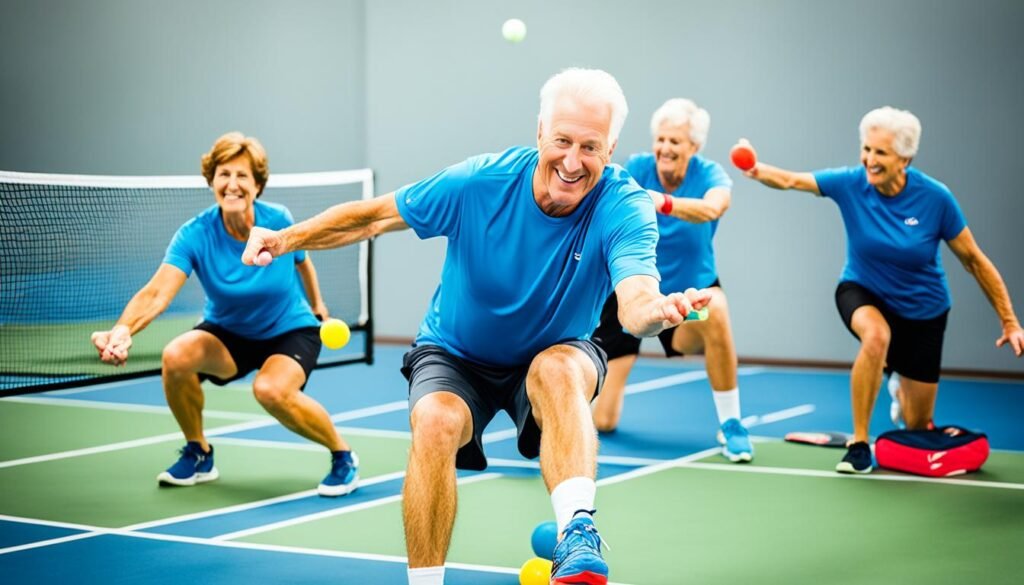Pickleball is a fun mix of tennis, badminton, and ping pong. It’s getting more and more popular. But, as more people play, the chance of getting hurt also goes up.
A recent study found that over 3,000 pickleball injuries are reported yearly. These injuries can be muscle strains, joint injuries, and more. It shows how important it is to be careful and prevent injuries while playing.
The Importance of Proper Warm-Up and Stretching
Proper warm-up and stretching can prevent many pickleball injuries. They get your muscles and joints ready for the game’s demands.
Dynamic stretching is great to warm up. It includes activities like walking lunges and high knees. This kind of stretching keeps you moving and boosts blood flow. It also makes you more flexible and enhances how well you perform. By doing this, you prepare the specific muscles you’ll use in pickleball. This lowers your chance of getting hurt.
It’s key to do stretches that focus on the muscles needed in pickleball. This includes your shoulders, elbows, knees, and ankles. Stretching these specific muscle groups makes them more flexible and reduces the risk of injury.
To get ready for pickleball, try these warm-up and stretching exercises:
- Arm circles: Stand with your feet apart. Stretch your arms out and make circles. Start small and get bigger. Do this 10 times in both directions.
- Quad stretches: Stand and pull your heel towards your butt. Keep your other leg slightly bend. Hold for 15-30 seconds, then switch legs.
- Shoulder rolls: Stand with your feet apart. Roll your shoulders up, back, and down. Do 10 rolls in each direction.
- Ankle rotations: Sit on a chair’s edge with one leg raised. Rotate your foot in circles. Do this in both directions 10 times, then switch legs.
Always do the exercises carefully and stay within what feels good. Don’t bounce when you stretch. As you get more flexible, slowly make your warm-up and stretches tougher.
Table:
| Warm-Up Exercises | Benefits |
|---|---|
| Walking lunges | Increases lower body strength and flexibility |
| High knees | Improves cardiovascular endurance and warms up leg muscles |
| Arm circles | Enhances shoulder mobility and flexibility |
| Quad stretches | Increases quadriceps flexibility and reduces risk of knee strain |
| Shoulder rolls | Improves shoulder range of motion and reduces tension |
| Ankle rotations | Increases ankle mobility and stability |
Adding a thorough warm-up and stretching routine is smart. It cuts the risk of muscle strains, sprains, and more. Prep your body well for pickleball. This way, you get to play more and worry less about injuries.
Building Strength and Stability
Preventing pickleball injuries means working out to make your muscles and joints strong and steady. By doing exercises for your core, lower, and upper body, you can get stronger. This lowers your chances of getting hurt when playing pickleball.
Lunges, squats, and planks are great for making your legs and core stronger. Lunges focus on your quads, hamstrings, and butt. Squats work many leg muscles at once. Planks are good for your core.
Resistance training with bands or weights is important for pickleball. It makes your muscles work longer and better, protecting you from injuries. Doing exercises like bicep curls and rows can make your upper body stronger.
Working on overall body stability is a must too. Stability exercises make you better at balancing and controlling your body. This cuts down the risk of falling and getting hurt.
Start with exercises that fit your body’s current shape. As you get stronger, you can add more challenges. A fitness pro can help you pick the right exercises for you.
Add these workouts to your exercise routine to play better pickleball. They help prevent muscle strains and keep you from getting hurt. This way, you’ll have more fun and fewer worries about injuries.
Nutrition Tips for Optimal Performance
Eating right is key for good pickleball play and staying safe from injuries. To keep up your energy and help your muscles get better, focus on:
- Eating a balanced diet that includes lean proteins, whole grains, fruits, and vegetables.
- Staying hydrated before, during, and after your matches.
- Having healthy fats, like avocados and nuts, for steady energy.
- Skipping sugary snacks and drinks to avoid dips in energy.
“Good nutrition is the base of doing well in sports. Give your body the right fuel to boost your pickleball and lower injury risks.” – Dr. Sarah Johnson, Sports Nutritionist
Combine a solid strength and stability plan with healthy eating. This way, you’ll cut down the chance of muscle strains and other injuries. Take good care of yourself, whether on the court or off, to enjoy pickleball fully.
| Exercise | Muscle Groups Targeted |
|---|---|
| Lunges | Quads, Hamstrings, Glutes |
| Squats | Quads, Hamstrings, Glutes, Calves |
| Planks | Core, Shoulders, Arms |
| Bicep curls | Biceps |
| Shoulder presses | Shoulders, Triceps |
| Rows | Back, Biceps |
| Single-leg balance | Legs, Core |
| Lateral lunges | Inner and Outer Thighs |
| Stability ball exercises | Core, Full Body |
Proper Technique and Form
Using correct technique and form in pickleball helps prevent injuries. It’s key to learn from a coach or someone who plays well. This ensures you’re doing things right. Practicing with good technique boosts your game and cuts injury risks.
For proper pickleball technique, start with the grip. Hold the paddle firmly for control. Also, work on your body stance and how you move your feet. A steady position and quick, purposeful steps are essential for hitting shots well.
“Proper technique is the foundation for success and injury prevention in pickleball. By mastering the fundamental aspects of the game, you can minimize the risk of strains, sprains, and other pickleball-related injuries.”
Pay close attention to how you swing. A fluid swing means more power and accuracy, less stress on your body. To swing well, twist your body and keep your grip relaxed.
Keeping good form is just as vital. It means moving in ways that don’t strain or harm. Having a coach watch your technique can spot and fix problems. This keeps you safe from injuries.
Pickleball demands a lot from you physically, needing quick moves and good coordination. by nailing the right form, you get to enjoy the sport safely and fully.
Proper Technique Tips:
- Learn from a coach or a skilled player for guidance.
- Get your grip right on the paddle.
- Stay solid on your feet and move with purpose.
- Work on a smooth, powerful swing with your whole body.
- Avoid any moves that might hurt you.
Protective Gear and Equipment
Preventing pickleball injuries starts with the right gear and equipment. Even though it’s low-impact, safety is key. Getting the right stuff means you can play the game more safely and without worry.
It all begins with the right shoes. You need athletic shoes that give support and a good grip. They help with those fast sideways movements. Proper shoes lower the risk of slipping and keep you stable on the court.
The best tennis shoes have firm outsoles that lower injury chances in pickleball. They boost grip for quick sideways moves.
Adding elbow braces or wrist supports is also smart. They cut down on injuries from overuse and keep those vulnerable joints safe. This is especially true for players with past elbow or wrist problems. It lets them play with more confidence and steadiness.
In short, the right gear is a big deal for staying injury-free in pickleball. Good athletic shoes and support for your joints are a must. They are key in keeping injuries at bay. So, invest in quality gear for peace of mind while playing.
Listening to Your Body and Resting When Needed
Listening to your body and knowing when to rest are crucial for staying injury-free in pickleball. Doing too much, without breaks, can lead to painful conditions. Pay attention to any discomfort and let your body heal with rest.
It’s key to notice what your body tells you while playing. Feeling pain that won’t go away, stiffness, or just being tired are signs you need a break. Ignoring these can make injuries worse and recovery longer.
“Pickleball is a tough game that tests your body’s limits. Breaks are as important as the play itself. They keep you away from injuries and playing for a long time.”
Regular breaks in playtime are crucial for your body to bounce back. Make sure to have days strictly for resting. This lets your muscles and joints recover fully.
Keep your body strong and injury-free by taking care of it. Use ice and stretch for muscle health. Icing after a game fights inflammation and eases your muscles. Stretching helps avoid injuries by keeping your muscles flexible.
Key Strategies for Rest and Recovery in Pickleball:
- Listen to your body and pause if you feel pain or extreme tiredness.
- Set aside rest days in your pickleball schedule.
- Do self-care like using ice and stretching to bounce back faster.
If you’re worried about your health or an injury, talk to a doctor. They can give you the right advice and care.
Age-specific Considerations and Pre-existing Conditions
In pickleball, preventing injuries is key. We need to think about the specific needs of different age groups and any health conditions they have. This is especially true for older players, ensuring they stay safe and avoid injuries is vital.
Older players benefit a lot from warming up and doing strengthening exercises. These help get their muscles and joints ready for the game. Working on the core, lower, and upper body strength helps reduce the chance of getting hurt. They should not push themselves too hard to avoid getting hurt.
People with conditions like arthritis need to know their limits and consult with doctors. They should create an exercise plan that fits their needs. This way, they can play pickleball safely without making their health conditions worse. It’s all about finding the right balance to stay healthy while having fun.
Considering age and health conditions means older players can still have a good time at pickleball. It’s about doing the right warm-ups, exercises, and being aware while playing. The main aim is to enjoy the game, keep moving, and be healthy.
Stay tuned to the next section where we will discuss the importance of proper technique and form in pickleball.
Conclusion
Preventing pickleball injuries is key to having fun and staying healthy. By using injury prevention methods, players can cut down on the risks on the court.
Start by always warming up and stretching before you play. This gets your body ready, lowering your chance of getting hurt.
It’s also smart to do exercises that make you stronger and more stable. A strong core and balanced muscles help you play better and avoid injuries.
Using the right form and technique is important too. Learn from players who know what they’re doing. This can keep you from getting hurt by moving wrong.
Don’t forget about wearing the right gear like shoes and braces. Having the right equipment boosts your safety while playing.
Listen to your body. Taking breaks and resting when you need it is crucial. It helps you avoid injuries and helps your body recover.
Also, think about your age and any health issues you might have. Older players and those with health problems can still play safely. They just need to be more careful and maybe adjust their warm-ups. Talking to a doctor can be a good step.
Follow these tips to prevent pickleball injuries. They’ll help you stay safe and enjoy the game for a long time.

